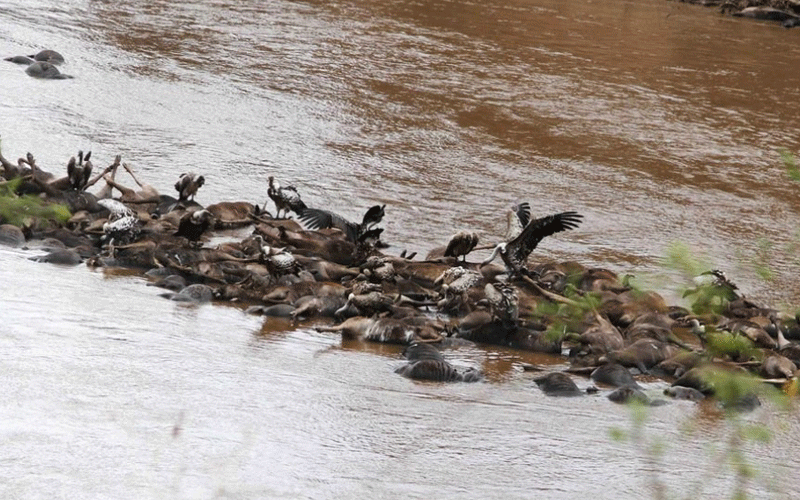Covid-19 resurgence abroad shatters travel prospects
By Peter Leshan, September 3, 2020The Great Wildebeest Migration in Masai Mara Game Reserve will continue to experience fewer tourists as coronavirus clusters re-emerge in Kenya’s main tourism markets abroad and fresh restrictions are imposed.
A surge in new coronavirus cases in Europe Asia and the US is threatening the recovery of Kenya’s vital travel sector, industry players have warned.
They say that going by the latest development, tourists planning to visit game reserves, parks and other attractions would not do so before the end of summer (later this month).
Normally, the wildebeest migration from Serengeti National Park in Tanzania to Masai Mara National Reserve in Kenya marks the beginning of the international tourists’ annual peak season between July and September, but with the new wave of infections, the countries are imposing fresh travel restrictions.
“We had started receiving inquiries from a number of people when cases of infections started dropping worldwide, but when the second wave of coronavirus struck about two weeks ago, inquiries stopped, meaning that they will not be visiting before the end of the peak season,” said Patrick Wanjohi, the managing director of Into Africa Eco Travel Ltd, an international travel agent.
He said tourists from some states in the US, the UK, South Korea and India were planning to visit the Mara, Watamu, Manda and Mombasa before the season peak ends, but Covid-19 resurgence cut short their plans.
A recent travel advisory by the US government to its citizens not to make non-essential travel to Kenya and some countries in East and South Africa and which received wide international media attention, he said, has also served to deny the country foreign arrivals, a month after it opened its airspace and tourism facilities.
Changed plans
Lilly Waddington, the proprietor of the UK based Magical Safaris Ltd and a director of Osero Camp in Mara and Magical Beach in Mombasa, told Travelwise that 12 tourists from Britain had planned to visit her establishments before mid this month (September), but the new wave of infections has forced them to reconsider their plans.
“The rising cases of infections after the numbers had been controlled has scared would be visitors. We are now banking on winter.
Hopefully, a vaccine for the virus would have been found,” she said as locals continue to visit the Mara weeks to the end of the peak season.
Meanwhile, wildlife conservation groups in the Mara have blamed blockages on wildebeests migration paths along banks of Mara River by tourists viewing the ongoing migration. Over the weekend, hundreds of wildebeests drowned in a suspected stampede while crossing the Mara River.
They said that the animals, which are migrating to Kenya to graze and mate know their migratory paths and when they are blocked, they take dangerous routes, which always lead to stampedes and drowning.
Nick Murero, the Mara-Serengeti Ecosystem coordinator for Lake Victoria Basin said that in an attempt to find alternative routes the animals used a swollen crossing point, but the tide was too strong for them to swim leading to drowning.
“Hundreds of tourists converged at the crossing points moments before they started crossing, forcing them to change paths.
Tourists should keep a distance to enable these animals to cross safely,” he cautioned.
Human encroachment
Mumero said Narok county government, which manages the reserve should enforce animals safety rules to deter future deaths, adding that more than 20, 000 wildebeests die every year while crossing the river because of human and car traffic in their migratory paths.
About 2.3 million out of about 2.5 million wildebeests, according to him have already crossed and are now on the Kenyan side.
Peter Kisimei, the Masai Mara Conservancies Association liason officer said tourists congestion at crossing points and the ongoing fencing in settlement areas, which were wildlife migratory corridors also add to the causes of the animal fatalities.
“Many other wildebeests die after being trapped by barbed wires in formerly migratory corridors, which are now settlement zones,” he said.
But according to Joseph Sindiyo, the Narok county senior warden for the reserve, stampede and drowning is part of the migration phenomenon.
He said the worst incident happened in 2007 when about 15,000 wildebeests drowned during a stampede near Mara Bridge.
“Even in Serengeti, they die in large numbers when crossing swollen rivers.
It is a game of the jungle and nature’s at its best. The more perilous and deep the route they choose, the more wildebeests are likely to die,” Sindiyo said, adding “When their leaders decide the path or route to use, the rest follow even if they are fraught with danger.”
